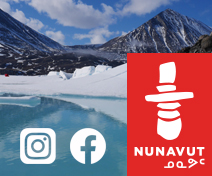Discover Canada

13 Reasons Why Canada Rocks
By Susan Maccallum-Whitcomb
Canada, being the world’s second largest country, covers a lot of ground. So its far-flung boundaries encompass many differences in terms of geography and culture. One thing, however, remains constant: wherever you go in this vast land, you’re sure to find something remarkable. Here are 13 of the reasons why Canada rocks.
1. 14,000 Shades Of Grey: British Columbia
In some places, red-breasted robins announce the arrival of spring. On the western shore of Vancouver Island, it’s the return of the grey whales—some 20,000 of which swim by as they make the 8,000-km (4,970-mi.) trip from the balmy breeding lagoons of Mexico to feeding grounds up north. Whale watching boats depart from towns like Ucluelet and Tofino. But since the massive mammals follow the coast closely, you can also observe them without leaving land. The peak viewing time in Pacific Rim National Park Reserve is from March through May (www.parkscanada.gc.ca/pacificrim).
2. Breakfast Of Champions: Alberta
Hungry attendees will be happy to hear that pancake flipping is as much a part of the Calgary Stampede as bull riding and barrel racing. In fact, an estimated 200,000 pancakes are served at free breakfasts hosted city-wide each July during the 10-day event. Many also come with a side order of entertainment. The tradition started in 1923 when chuckwagon driver Jack Morton began inviting random folks to share his morning meal; now it serves as edible evidence of that legendary Western hospitality (www.stampedebreakfast.ca).
3. Fish Tales: Saskatchewan
Saskatchewan may call to mind waving fields of prairie grain, yet this landlocked spot has real waves as well. In fact, 100,000 or so lakes and rivers cover about a tenth of the province, providing some of the best freshwater fishing anywhere. World record-breaking burbot, northern pike and brook trout have been caught here; trophy-sized walleyes—Saskatchewan’s official provincial fish and its most popular game species—also lure in anglers. Whether you are passionate about fly fishing or eager to try ice fishing, experienced local outfitters can set you up (www.tourismsaskatchewan.com/things-to-do/fishing).
4. Bear Necessities: Manitoba
You can see a polar bear just by picking up a “toonie”—the two-dollar coin. But if you want an up-close look at the planet’s largest land predators, make tracks for Churchill. This tiny community on the western shore of Hudson Bay is one of the only human settlements where they can be seen in the wild. Because it sits on a polar bear migra-tion route, hundreds pass through as they travel to the ice floes in October and November. Cool Tundra Buggies—complete with oversized wheels and an outside viewing platform—take guests to observe them on unforgettable day tours (www.travelmanitoba.com/churchill).
5. Dramatic Events: Ontario
Shakespeare said “All the world’s a stage,” and Stratford—a small city in southwestern Ontario named for the Bard’s birthplace in the U.K.—actually feels like one during its signature event. Typically, each year, from mid-April through October, the Stratford Festival draws nearly half a million theatregoers to multiple venues. Founded in 1953, it had humble beginnings: plays were originally performed in a giant canvas tent and the season lasted six weeks. From the start, however, the festival attracted luminaries from the theatre world. Sir Tyrone Guthrie was its first artistic director and Sir Alec Guinness starred in its inaugural production of Richard III (www.stratfordfestival.ca).
6. Cold Comfort: Québec
What beats walking in a winter wonderland? How about sleeping in one? At the Hôtel de Glace, everything—including the glittering guest room furniture—is made entirely of ice and snow: some 3,000 blocks of ice. Its thick walls act like a thermos, so you can chill without getting too chilly; and the ice-block beds, topped with a solid wood base and a comfortable mattress, an isolating bed sheet and Arctic-rated sleeping bags, are très cosy. Built anew each year, the Hôtel de Glace in Valcartier Vacation Village is open from January to late March (www.valcartier.com/en/lodging/hotel-de-glace-ice-hotel)
7. Claws Célèbre: New Brunswick
Shediac, a cute Acadian fishing community, bills itself as the “Lobster Capital of the World.” Whether or not that’s technically true, this town obviously loves the King of Crustaceans. One is proudly displayed on its coat of arms; another—a 55-tonne whopper, albeit made from metal—is its main attraction. Moreover, since 1949, it has honoured the catch du jour each July during the nine-day Shediac Lobster Festival. A favourite event, “La Grande Table,” is the famous lobster dinner served on a gigantic, long table where hundreds of people gather for a delicious locally sourced meal (www.shediaclobsterfestival.ca).
8. Cliff Notes: Nova Scotia
The Joggins Fossil Cliffs on Chignecto Bay are more than just another pretty rock face. After all, they provide an unparalleled look at what life was like 300 million years ago during the Pennsylvanian “Coal Age” of Earth history. Some 200 species of fossilized plants and animals have been discovered here, among them Hylonomus lyelli, the earliest known reptile and the first known vertebrate able to live entirely on land. Cited by Charles Darwin in The Origin of Species, this 15-km-long (9.3-mi.), tide-washed UNESCO World Heritage Site has been dubbed the “Coal Age Galápagos” (www.jogginsfossilcliffs.net).
9. A Record-Breaking Bridge: Prince Edward Island
Although PEI joined Confederation in 1873, the province wasn’t physically connected to the rest of Canada until the billion-dollar Confederation Bridge opened between Borden-Carleton and Cape Jourimain, New Brunswick, 124 years later. Comprised of almost 13 km (8 mi.) of curvaceous concrete, the so-called “fixed link” qualifies as the longest bridge in the world spanning ice-covered water. It took a team of more than 5,000 workers four years to build this 11-m-wide (36-ft.) engineering marvel; motorists can cross it in a mere 12 minutes (www.confederationbridge.com).
10. Mixed Signals: Newfoundland & Labrador
The provincial capital’s leading landmark, Signal Hill, is crowned by an imposing stone tower, which was erected to commemorate the arrival of Giovanni Caboto in 1497. The Genoese explorer is better known to anglophones as John Cabot. Coincidently, all of the modern-day visitors who tweet about the tower or post cellphone pics of it to Facebook and Instagram owe a debt to another trail-blazing Italian, Guglielmo Marconi. The radio pioneer ushered in the era of global communications when he received the first transatlantic wireless signal here on December 12, 1901 (www.parkscanada.gc.ca/signalhill).
11. A Decidely Different Drink: Yukon
More than a century after the Klondike Gold Rush ended, Dawson City is still a place where “strange things are done in the midnight sun.” If you want proof—about 40 proof to be precise—head to the Sourdough Saloon in the Downtown Hotel and order a Sourtoe Cocktail. The off-beat beverage has one key ingredient that hip mixologists tend to overlook—namely a dehydrated human toe. To become a certificate-carrying member of the Cocktail Club, you can drink your shot fast or you can drink it slow, “but your lips must touch the gnarly toe” (www.dawsoncity.ca/sourtoe-cocktail-club).
12. Celestial Sights: Northwest Territories
Neither words nor pictures can truly convey the beauty of the aurora borealis, a natural phenomenon sparked by surges of solar and magnetic energy. You simply have to see the iridescent colours dance across the night sky yourself. An ideal place to see it is the Northwest Territories, where “the greatest light show on Earth” is visible about 240 days a year. The absence of light pollution in Wood Buffalo National Park—Canada’s largest national park and the world’s largest Dark Sky Preserve—creates top viewing opportunities from mid-August to mid-March (www.parkscanada.gc.ca/woodbuffalo).
13. Sinking Sensations: Nunavut
Nunavut doesn’t make headlines often, but in 2014 the news went viral: after 168 years, the HMS Erebus—one of the ships from the ill-fated Franklin Expedition—had been discovered in its icy waters by Parks Canada archaeologists. The feat was repeated in 2016 when her sister ship, the HMS Terror was located. Sir John Franklin, his crew and both vessels disappeared in 1846 while trying to traverse the Northwest Passage—and gain a lucrative trade route between the Atlantic and Pacific. Finding them helps solve one of the world’s great marine mysteries (www.parkscanada.gc.ca/franklin).






